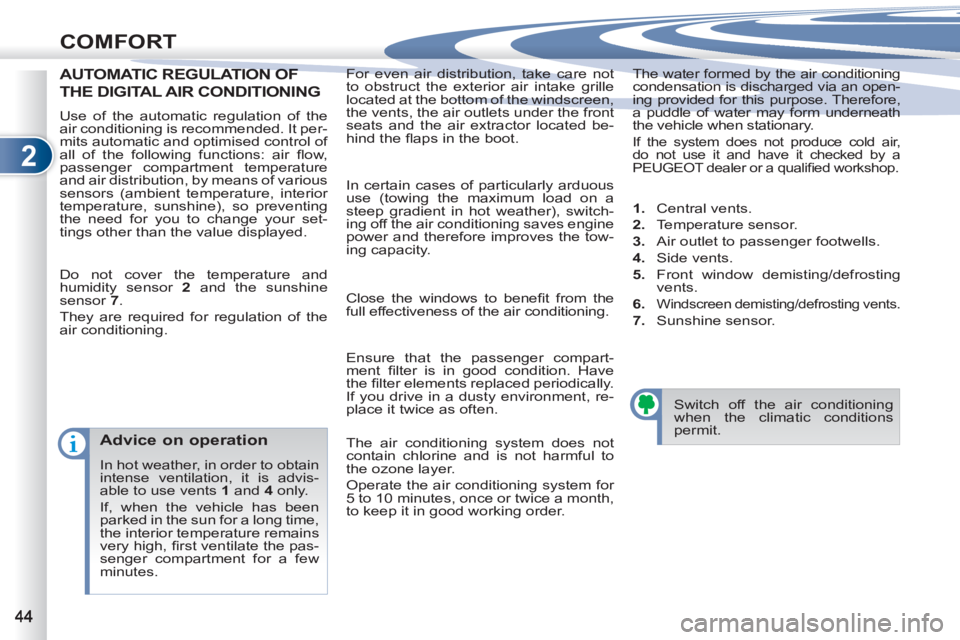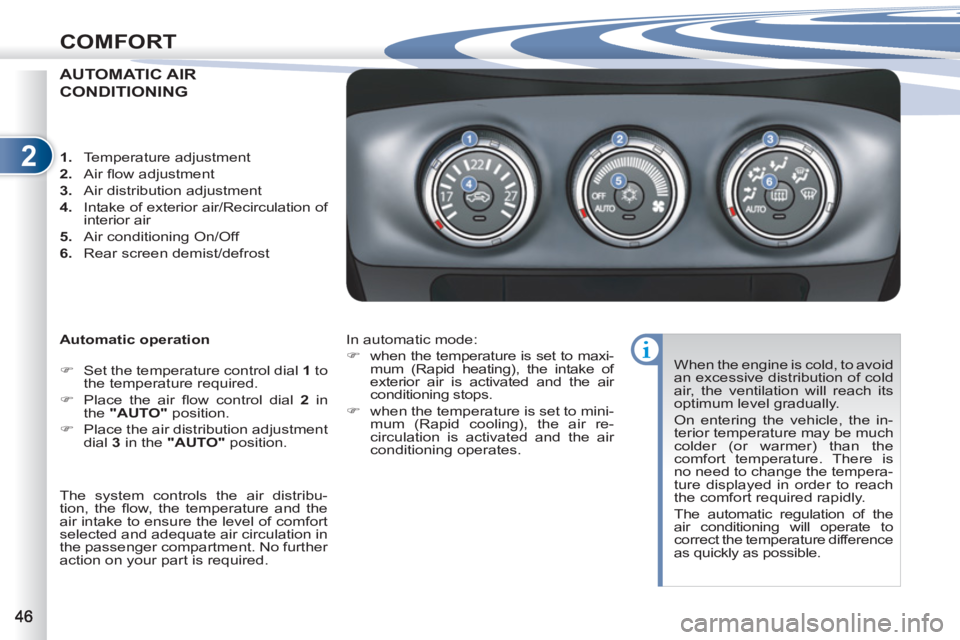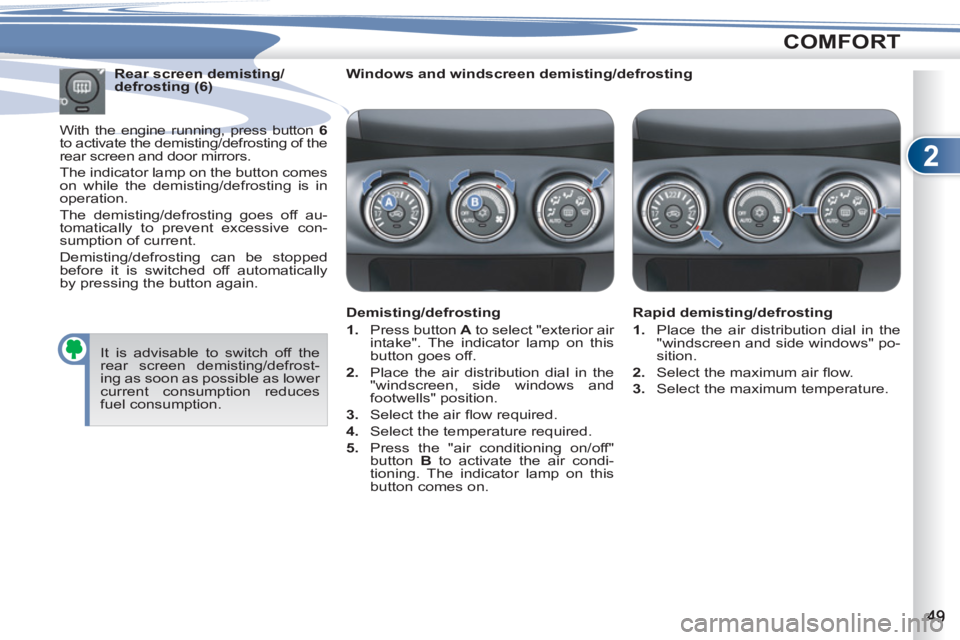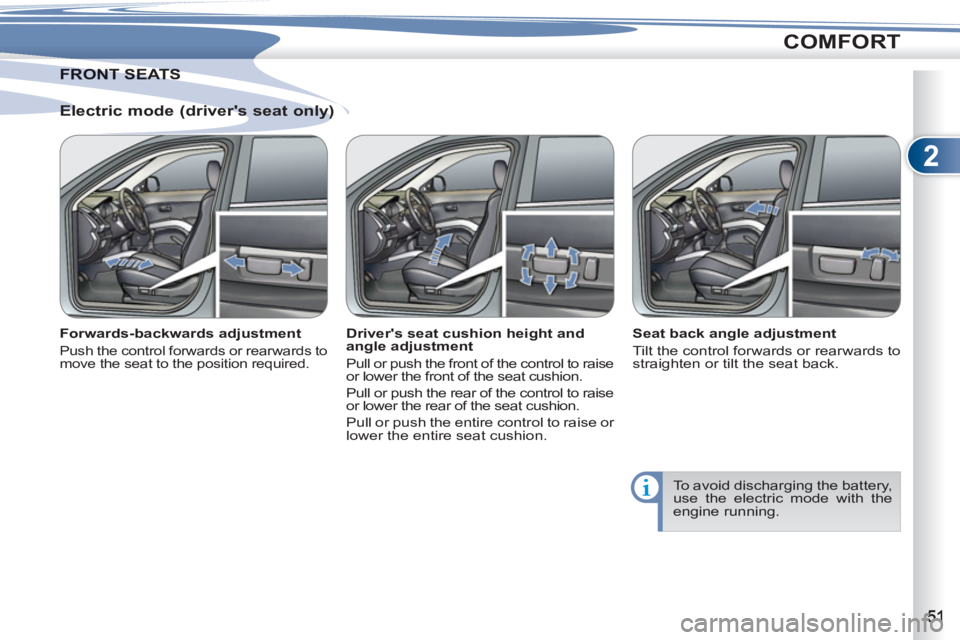2012 PEUGEOT 4007 engine
[x] Cancel search: enginePage 29 of 236

1
!
INSTRUMENTS and CONTROLS
Message
is on
Cause
Solution - action
Observations
Airbags
Fixed Fault in the airbags or
pretensioners. Contact a PEUGEOT
dealer or a qualifi ed
workshop.
Service
Fixed Problem in one of the
systems which does
not have a specifi c
message. Stop the vehicle and
contact a PEUGEOT
dealer or a qualifi ed
workshop. To identify the problem,
contact a PEUGEOT
dealer or a qualifi ed
workshop.
Engine oil
pressure
Fixed Engine oil pressure too
low or fault in the engine
lubrication system. Stop the vehicle and
contact a PEUGEOT
dealer or a qualifi ed
workshop.
Engine oil
level
Fixed Engine oil level too low. Stop the vehicle and
check the level using the
dipstick. If there is a lack of oil,
top up the level.
Low fuel
warning
Fixed The fuel level is low. Refuel as soon as
possible.
Fuel system
Fixed Fuel system fault. Contact a PEUGEOT
dealer or a qualifi ed
workshop.
Opening
not closed
correctly
Fixed One of the doors or the
tailgate is not closed
correctly. Close the door or the
tailgate. The opening concerned
is indicated on the
screen.
Page 31 of 236

1
INSTRUMENTS and CONTROLS
Message
is on
Cause
Solution - action
Observations
Saturation of
the particle
emission fi lter
Fixed Start of saturation of the
particle emission fi lter. As soon as traffi c
conditions permit,
regenerate the fi lter by
driving at a speed of at
least 35 mph (60 km/h)
until the message is
cleared. If the message is still
displayed, contact a
PEUGEOT dealer or a
qualifi ed workshop.
Diesel
additive level
Fixed Low Diesel additive
level. Have the level topped
up by a PEUGEOT
dealer or a qualifi ed
workshop without delay.
Water in the
Diesel fi lter
(according to
country)
Fixed The presence of water
in the Diesel fi lter is
indicated.
Risk of damage to the
injection system on
Diesel engines. Contact a PEUGEOT
dealer or a qualifi ed
workshop without delay.
Page 33 of 236

1
INSTRUMENTS and CONTROLS
The total distance is dis-
played in zone 1
of the
screen and the trip dis-
tance in zone 2
(refer to
the "Distance recorders"
section).
Distance recorder (A and B)
INFORMATION ON TINFORMATION ON THE
INSTRUMENT PANEL SCREEN
Information display
With the ignition on, press the INFO
but-
ton, located on the fascia to the left of the
instrument panel, to display the various
types of information in succession:
- distance recorder A,
- distance recorder B,
- service indicator,
- coolant temperature,
- range,
- trip computer,
- setting menu.
This displays the dis-
tance and the number
of months remaining be-
fore the next service, in
line with the manufactur-
er's servicing schedule
(refer to the "Service in-
dicator" section).
Service indicator
When the engine is run-
ning, this indicates the
temperature of the cool-
ant (refer to the "Coolant
temperature indicator"
section).
Coolant temperature When the engine is run-
ning, this indicates the
number of miles (kilo-
metres) which can still
be travelled with the fuel
remaining in the tank,
based on the average
fuel consumption over
the last few miles (kilometres) travelled
(refer to the "Range" section).
Range
This indicates the aver-
age fuel consumption,
the average speed and
the current fuel con-
sumption (refer to the
"Trip computer" section).
Trip computer
When the vehicle is
stationary
, this allows
the user to change the
following settings (refer
to the "Setting menu"
section):
- the display language,
- the temperature dis-
play units,
- the fuel consumption units,
- the option to reinitialise the average
fuel consumption and the average
speed,
- the break (rest) reminder display
interval.
Setting menu
Page 34 of 236

1
INSTRUMENTS and CONTROLS
The total distance is dis-
played in zone 1
of the
screen and the trip dis-
tance in zone 2
.
DISTANCE RECORDERS (A/B)
System for measuring the total distance
travelled by the vehicle during its ser-
vice life and the distance travelled in
a day or other period until it is reset to
zero by the driver.
Zero reset
With the ignition on, press the INFO
button for more than 2 seconds until
zeros appear.
When the engine is run-
ning, this indicates the tem-
perature of the coolant.
COOLANT TEMPERATURE
If the bar is close to the critical
position
located on the right, the temperature is
too high.
The symbol fl ashes when your engine
is overheating.
You must stop your vehicle as soon
as it is safe to do so.
Wait a few minutes before switching
off the engine.
Wait for the engine to cool be-
fore topping up the level. The
cooling system is pressurised.
When the engine is
running
, this indicates
the distance which can
still be travelled with
the fuel remaining in the
tank based on the aver-
age fuel consumption
over the last few miles/
kilometres travelled.
RANGEGE
When the range is less than 30 miles
(50 km)
, dashes are displayed.
Refuel as soon as possible. The display
of the range is updated.
To avoid any risk of scalding,
unscrew the cap by two turns to
allow the pressure to drop.
When the pressure has dropped, remove the cap and top up the
level, if necessary.
Contact a PEUGEOT dealer or
a qualifi ed workshop. This fi gure may increase fol-
lowing a change in the style of
driving or the relief, resulting in
a reduction in the current fuel
consumption.
If you only add a few litres, the
value displayed will be incorrect.
Therefore, you must fi ll the tank
whenever possible.
When you disconnect the bat-
tery, the previous fuel consump-
tion data is lost and the value
displayed will be different from
that displayed before the battery was disconnected. The distance
displayed must be considered
an approximate indication.
Page 46 of 236

2
COMFORT
For even air distribution, take care not
to obstruct the exterior air intake grille
located at the bottom of the windscreen,
the vents, the air outlets under the front
seats and the air extractor located be-
hind the fl aps in the boot. The water formed by the air conditioning
condensation is discharged via an open-
ing provided for this purpose. Therefore,
a puddle of water may form underneath
the vehicle when stationary.
If the system does not produce cold air,
do not use it and have it checked by a
PEUGEOT dealer or a qualifi ed workshop.
AUTOMATIC REGULATION OF ON OF
THE DIGITAL AIR CONDITIONING
Do not cover the temperature and
humidity sensor 2
and the sunshine
sensor 7
.
They are required for regulation of the
air conditioning.
Advice on operation
In hot weather, in order to obtain
intense ventilation, it is advis-
able to use vents 1
and 4
only.
If, when the vehicle has been
parked in the sun for a long time,
the interior temperature remains
very high, fi rst ventilate the pas-
senger compartment for a few
minutes. Switch off the air conditioning
when the climatic conditions
permit. Use of the automatic regulation of the
air conditioning is recommended. It per-
mits automatic and optimised control of
all of the following functions: air fl ow,
passenger compartment temperature
and air distribution, by means of various
sensors (ambient temperature, interior
temperature, sunshine), so preventing
the need for you to change your set-
tings other than the value displayed. In certain cases of particularly arduous
use (towing the maximum load on a
steep gradient in hot weather), switch-
ing off the air conditioning saves engine
power and therefore improves the tow-
ing capacity.
Close the windows to benefi t from the
full effectiveness of the air conditioning.
Ensure that the passenger compart-
ment fi lter is in good condition. Have
the fi lter elements replaced periodically.
If you drive in a dusty environment, re-
place it twice as often.
The air conditioning system does not
contain chlorine and is not harmful to
the ozone layer.
Operate the air conditioning system for
5 to 10 minutes, once or twice a month,
to keep it in good working order.
1.
Central vents.
2.
Temperature sensor.
3.
Air outlet to passenger footwells.
4.
Side vents.
5.
Front window demisting/defrosting
vents.
6.
Windscreen demisting/defrosting vents.
7.
Sunshine sensor.
Page 48 of 236

2
COMFORT
AUTOMATIC AIR
CONDITIONING
Automatic operation
�)
Set the temperature control dial 1
to
the temperature required.
�)
Place the air fl ow control dial 2
in
the "AUTO"
position.
�)
Place the air distribution adjustment
dial 3
in the "AUTO"
position. When the engine is cold, to avoid
an excessive distribution of cold
air, the ventilation will reach its
optimum level gradually.
On entering the vehicle, the in-
terior temperature may be much
colder (or warmer) than the
comfort temperature. There is
no need to change the tempera-
ture displayed in order to reach
the comfort required rapidly.
The automatic regulation of the
air conditioning will operate to
correct the temperature difference
as quickly as possible.
1.
Temperature adjustment
2.
Air fl ow adjustment
3.
Air distribution adjustment
4.
Intake of exterior air/Recirculation of
interior air
5.
Air conditioning On/Off
6.
Rear screen demist/defrost
In automatic mode:
�)
when the temperature is set to maxi-
mum (Rapid heating), the intake of
exterior air is activated and the air
conditioning stops.
�)
when the temperature is set to mini-
mum (Rapid cooling), the air re-
circulation is activated and the air
conditioning operates.
The system controls the air distribu-
tion, the fl ow, the temperature and the
air intake to ensure the level of comfort
selected and adequate air circulation in
the passenger compartment. No further
action on your part is required.
Page 51 of 236

2
COMFORT
Windows and windscreen demisting/defrosting
Demisting/defrosting
1.
Press button A
to select "exterior air
intake". The indicator lamp on this
button goes off.
2.
Place the air distribution dial in the
"windscreen, side windows and
footwells" position.
3.
Select the air fl ow required.
4.
Select the temperature required.
5.
Press the "air conditioning on/off"
button B
to activate the air condi-
tioning. The indicator lamp on this
button comes on.
Rapid demisting/defrosting
1.
Place the air distribution dial in the
"windscreen and side windows" po-
sition.
2.
Select the maximum air fl ow.
3.
Select the maximum temperature.
Rear screen demisting/
defrosting (6)
With the engine running, press button 6
to activate the demisting/defrosting of the
rear screen and door mirrors.
The indicator lamp on the button comes
on while the demisting/defrosting is in
operation.
The demisting/defrosting goes off au-
tomatically to prevent excessive con-
sumption of current.
Demisting/defrosting can be stopped
before it is switched off automatically
by pressing the button again.
It is advisable to switch off the
rear screen demisting/defrost-
ing as soon as possible as lower
current consumption reduces
fuel consumption.
Page 53 of 236

2
COMFORT
Electric mode (driver's seat only)
Forwards-backwards adjustment
Push the control forwards or rearwards to
move the seat to the position required.
Driver's seat cushion height and
angle adjustment
Pull or push the front of the control to raise
or lower the front of the seat cushion.
Pull or push the rear of the control to raise
or lower the rear of the seat cushion.
Pull or push the entire control to raise or
lower the entire seat cushion.
Seat back angle adjustment
Tilt the control forwards or rearwards to
straighten or tilt the seat back.
ONT SEATSFRONT SEATS
To avoid discharging the battery,
use the electric mode with the
engine running.